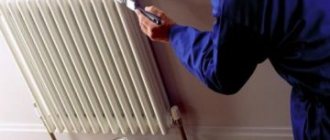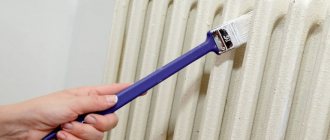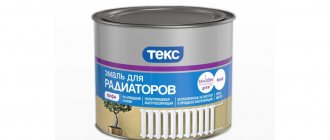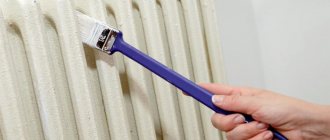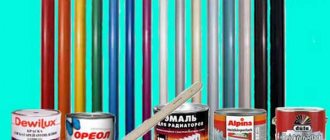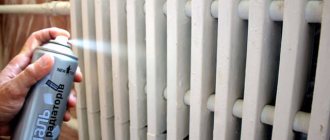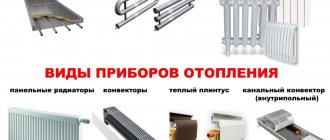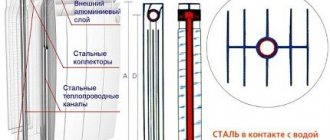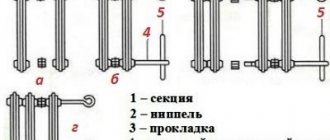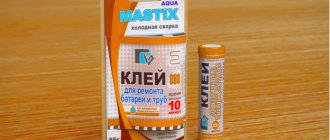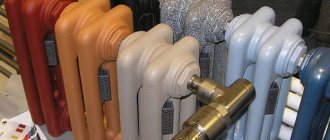No matter how high-quality and beautiful the coating of the heating radiators in your home is, sooner or later it will lose its shine and develop stains, scratches and other defects. There is only one way to get rid of these negative consequences - repaint the radiators. But here, as expected, the question arises: which odorless paint to choose? Finding the right answer requires an integrated approach. So, first, we suggest you understand the requirements that coloring substances for heating devices must meet, then find out what types of these substances can be used to update batteries, and finally, read reviews about them.
What kind of paint should be used for batteries?
Basic requirements for paint for radiators:
- Non-toxic - the coloring composition should not emit a pungent odor or harmful substances when heated.
- Anti-corrosion properties - materials must be resistant to rust.
- High strength - the new coating should not flake off or flake off the surface of the batteries.
- Resistance to elevated temperatures - the paint should not deform when heated.
- Durability – the product should retain its color and texture for as long as possible.
Based on these requirements, oil-based, ordinary aluminum and pentaphthalic paints are not suitable for painting radiators - they emit an unpleasant odor and are deformed when exposed to high temperatures.
Choose formulations that do not emit harmful substances when heated
But the most optimal paints for batteries are the following:
- acrylic;
- silicone-aluminum;
- alkyd;
- water-dispersed.
Important! When purchasing any of these paints, you need to take into account its purpose: the packaging of the composition should indicate that it can be used specifically for coating hot metal surfaces.
Materials and tools
To work you will need:
- sandpaper P180 (according to the new GOST) for removing old paint and P400 for sanding before painting;
- knife or narrow spatula;
- metal brush;
- solvent for removing old paint;
- primer for metal;
- ready-to-use paint. Can be purchased in aerosol cans, which simplifies the painting process. True, it is much more expensive;
- a small roller (needed for batteries with a flat surface of the fins);
- paint brushes of different shapes and sizes (flat brushes 20 and 50 mm wide) and radiator brushes, 20 mm wide (different from the usual long curved handle);
- paint cuvette;
- rag;
- polyethylene film to protect floors and walls from paint splashes.
Acrylic paints
Acrylic paints are widely used for the treatment of radiators, as they have no odor and effectively withstand high temperatures: they do not crack or turn yellow when heated. One of the main advantages of such compositions is a wide range of shades and great opportunities for decorative design of batteries: after the paint dries, an even coating with a very rich color is formed.
Materials of the acrylic group are characterized by high moisture resistance, so they do not fade with regular wet cleaning.
Almost the only disadvantage of acrylic paints is the relatively high cost.
Advice. Acrylic paints are the best option for bimetallic and aluminum radiators: the surface of these devices is protected by a special powder layer, which complicates the painting process, and acrylic compositions are easy to apply even to such a specific coating.
Painting aluminum radiators
Aluminum batteries themselves have a neat-looking and even finish and do not require additional painting. If the convection plates of the radiator are located very often, then painting them will significantly reduce the heat transfer of the device.
If their appearance hurts the eye, then it is better to cover them with a screen or force them with furniture. If for some reason these options are not suitable, then the radiators, of course, can be painted. But paints suitable for cast iron batteries will not adhere well to an aluminum surface. Such radiators should only be painted using a spray can. Moreover, this should be done during the heating season, because on cold radiators at room temperature the paint will take a very long time to dry.
Important! It should be noted that most manufacturers of aluminum radiators consider their unauthorized painting to be sufficient reason to terminate warranty service.
Alkyd paints
There are three types of alkyd paints for radiators:
- organic;
- silicon-organic;
- aquatic.
Applying paint to batteries
All these compounds are moisture resistant and have an affordable price. The base color of the paint is white, but any coloring pigments can be added to it, so the color palette of the products is quite wide. According to manufacturers, alkyd compositions do not deform at temperatures up to 150 degrees. The only exception is light paints - they can begin to lose their original color already at temperatures above 100 degrees.
As for the smell, it occurs only during direct staining. The smell quickly disappears, so that after the radiators dry, not a trace remains of it.
Advice. If you like white alkyd paint, make sure that it contains not chalky, but titanium pigment: the first product, although it costs much less, can become noticeably yellow over time.
Dyeing process
It is better to paint batteries outside the heating season, then the paint will dry evenly and there will be no smudges, cracks, swelling, etc. If this is not possible, then apply as thin a layer as possible. Ideally, if the battery is not yet installed, or you can remove it to paint everywhere.
Important! All water based paints must be applied over a primer. When applied directly to the metal of the battery, you will have to deal with the rapid appearance of rust through the paint.
To keep the floor clean, you should lay unnecessary cloth or newspapers under the radiator. If the dye is applied from a spray can, you will also have to cover the adjacent surface of the walls with something.
Painting the battery with a brush
For work, it is better to choose brushes with soft bristles; they will create less splashes. A regular old toothbrush will help you get to those hard-to-reach places. To avoid getting dirty on an already painted surface, it is better to first paint the internal parts of the radiator. Paint should be applied from the top of the radiator downwards.
You shouldn’t try to immediately paint the battery evenly in one layer, it’s still unlikely to work. It would be better to use two neat thin layers, because one thick one will take much longer to dry and may leak. The time it takes for the dye layer to dry completely is usually indicated on the packaging. You should not apply the second layer ahead of time; the coating will turn out uneven and sloppy.
Painting can be done not only by hand, but also with a spray gun or from a spray can.
Battery paint in a can
Water-dispersion paints
Another popular coating option for radiators, the main advantage of which is its unconditional environmental safety. This advantage is provided by the composition of the paints: their main natural component is water, in which, in turn, special dispersed particles are dissolved, which also do not pose any danger to the human body. Such materials are odorless, dry very quickly and retain their aesthetic appearance for a long time. In the basic version, the compositions are white, but with the help of special pigments they can easily be given any other shades.
The paints are characterized by a water-repellent effect, thanks to which the batteries can be washed frequently without fear of deforming the coating.
Perhaps the only disadvantage of water-dispersion paints is their relatively low resistance to elevated temperatures, due to which they are less durable than other materials under consideration.
Silicone-aluminum paints
If you want to paint heating radiators as thoroughly and for a long time as possible, without a doubt choose silicone-aluminum paint. It is based on silicone resin, which in combination with aluminum produces a material that can withstand very high temperatures - up to 500 degrees. After the paint dries, a dense but very plastic coating is formed that can withstand all temperature contractions and expansions of the metal without consequences. The painted surface is so durable that it is not afraid of any cracks.
Choose paint for your type of heating radiator
The paint does not require preliminary priming of heating devices, since it itself has fairly high adhesion to various working surfaces.
However, silicone-aluminum paints have two disadvantages. The first is that during application the material emits an unpleasant odor. But here, in fairness, we note that after the batteries dry out, it disappears. The second disadvantage is the high price.
As you can see, it is recommended to use four types of paints to update batteries: acrylic, alkyd, water-dispersion and silicone-aluminum - all of them do not have a pungent odor, do not peel off when exposed to high temperatures and dry quickly. At the same time, they all differ in their operational features - be sure to take them into account so as not to make a mistake with the final choice.
Glossy or matte
When choosing paint for heating radiators, you need to choose what type of surface you want to get - matte or glossy. You need to choose based on the type of surface. The fact is that glossy paint emphasizes surface unevenness. Cast iron batteries are most often painted, but their surface is far from ideal. By covering it with a glossy composition, you will only emphasize its imperfection.
Matte compositions are better in this regard - they visually hide many irregularities. So this is a good option. But there is also a drawback: matte white paint quickly acquires a grayish tint. This happens due to the fact that dust and dirt get clogged into the pores, and they are wide in matte paint. This dirt is not washed out from there. The solution is a fresh coat of paint or painting in a color other than white. A smart choice is to match the paint to the color of the walls. From a design point of view, this is a better solution than white radiators.
If there is a pattern on a cast iron radiator, the gloss will emphasize and highlight it
There is another way out - to repair the unevenness of the radiator. This is done using metal putty, you can use automotive putty. First, old paint, rust and other contaminants are removed, then the surface is degreased and then all irregularities are sealed with putty. After it dries, use sandpaper with medium, then fine grain, and sand the surface until smooth. Then it is dusted, primed and painted. In this case, you can safely use glossy enamels for heating radiators. If the surface is leveled carefully, you will be pleased with the result.
